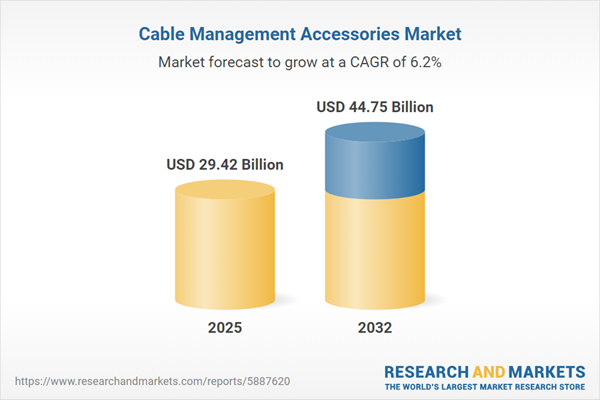Speak directly to the analyst to clarify any post sales queries you may have.
The cable management accessories market is positioned as a foundational component in modern infrastructure, providing robust, safe, and organized solutions for managing electrical and data cabling across industries where system performance and reliability are paramount.
Market Snapshot: Cable Management Accessories Market
The Cable Management Accessories Market grew from USD 27.71 billion in 2024 to USD 29.42 billion in 2025. The market is expected to continue expanding at a CAGR of 6.17%, reaching USD 44.75 billion by 2032. This notable trajectory reflects the sector’s response to rapid digitalization, security protocols, and evolving infrastructure requirements, underlying the segment’s strategic significance for senior decision-makers seeking growth and operational continuity in a competitive landscape.
Scope & Segmentation
This report delivers a granular view of the cable management accessories sector, examining the critical intersections of technology, compliance, user needs, and channel evolution. Key segmentation categories are outlined as follows:
- Product Types: Cable clips (adhesive mount, screw mount), cable sleeves (braided, expanded, spiral), cable ties (heavy duty, marker, releasable, standard), cable trays (ladder, perforated, solid bottom), ducts and conduits (flexible, rigid).
- Material Types: Metal (aluminum, stainless steel), plastic (nylon, PVC).
- End Users: Automotive and transportation (aftermarket, OEM), commercial (electrical installations, networking infrastructure), data centers (colocation, hyperscale), industrial (chemical, manufacturing, oil and gas), residential (consumer electronics, home appliances).
- Sales Channels: Offline (distributors, retailers, specialized stores), online (e-commerce platforms, manufacturer direct).
- Regions Covered: Americas (North America, Latin America), Europe, Middle East & Africa (Europe, Middle East, Africa), Asia-Pacific.
- Key Companies Analyzed: TE Connectivity Ltd, Legrand SA, Schneider Electric SE, Eaton Corporation plc, ABB Ltd, 3M Company, Atkore International Group Inc, nVent Electric plc, Panduit Corp., Nexans SA.
Cable Management Accessories Market – Key Takeaways
- Increasing complexity in electrical and data infrastructures is driving demand for advanced cable management solutions that prioritize safety, efficiency, and maintainability.
- Material selection is pivotal, with end users weighing durability, corrosion resistance, and adaptability for specialized needs, especially in automotive, industrial, and high-density residential environments.
- End user preferences are diversifying, as hyperscale data centers seek integrated monitoring and fire-retardant properties, while residential segments require aesthetically compatible and easily installed solutions.
- Sales strategies are evolving, balancing traditional distributor relationships for large-volume deals with the expanding role of digital platforms that enable rapid, customizable procurement.
- Regional dynamics matter, with North America favoring regulated, certified products and Asia-Pacific leading in production innovation and scale. Meanwhile, EMEA markets are shaped by diverse regulatory requirements and heightened focus on sustainability.
- Collaboration between manufacturers and distributors is increasingly important for achieving market reach, optimizing technical support, and capturing value in specialized channel segments.
Tariff Impact and Global Supply Chain Adaptation
Recent tariff measures in the United States have influenced both sourcing and cost structures in the cable management accessories market. Supply chain resilience has risen in priority, with companies strategically diversifying manufacturing bases and renegotiating contracts to manage landed cost increases. These shifts also promote the adoption of design efficiencies that optimize material use and align with sustainability commitments, reinforcing the need for flexible and proactive operational strategies in a fluctuating international environment.
Methodology & Data Sources
The research utilizes a combination of extensive secondary analysis, structured expert interviews, and targeted procurement surveys. This approach integrates qualitative insight with quantitative validation, ensuring the reliability and breadth needed to deliver actionable intelligence for C-level leaders.
Why This Report Matters for Cable Management Accessories Decision-Makers
- Enables risk-aware planning by mapping emerging technological trends and regulatory developments directly impacting product compliance and market access.
- Supports informed procurement and partnership strategies through in-depth coverage of manufacturer initiatives, sales channels, and regional demand patterns.
- Equips executive teams with segment-specific insights that facilitate agile response to cost, supply chain, and sustainability pressures—critical for long-term competitiveness.
Conclusion
The cable management accessories market is evolving rapidly, shaped by technology, regulatory requirements, and shifting customer expectations. This report empowers leaders to navigate industry transformation and strategically position their organizations for sustained growth and differentiation.
Additional Product Information:
- Purchase of this report includes 1 year online access with quarterly updates.
- This report can be updated on request. Please contact our Customer Experience team using the Ask a Question widget on our website.
Table of Contents
3. Executive Summary
4. Market Overview
7. Cumulative Impact of Artificial Intelligence 2025
Companies Mentioned
The companies profiled in this Cable Management Accessories market report include:- TE Connectivity Ltd
- Legrand SA
- Schneider Electric SE
- Eaton Corporation plc
- ABB Ltd
- 3M Company
- Atkore International Group Inc
- nVent Electric plc
- Panduit Corp.
- Nexans SA
Table Information
| Report Attribute | Details |
|---|---|
| No. of Pages | 194 |
| Published | October 2025 |
| Forecast Period | 2025 - 2032 |
| Estimated Market Value ( USD | $ 29.42 Billion |
| Forecasted Market Value ( USD | $ 44.75 Billion |
| Compound Annual Growth Rate | 6.1% |
| Regions Covered | Global |
| No. of Companies Mentioned | 11 |









